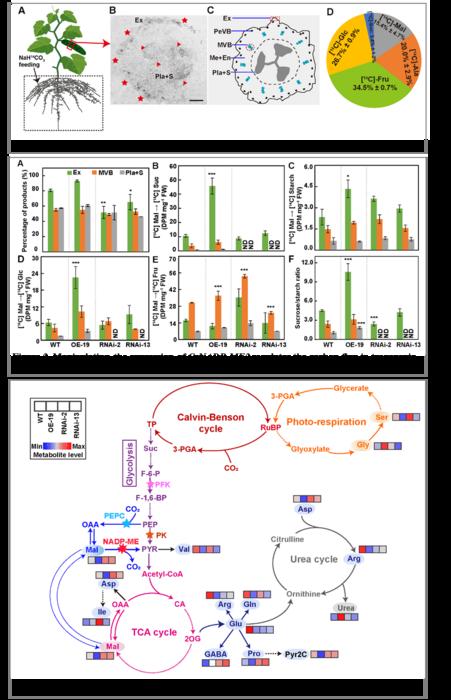image:
.
view more
Credit: Horticulture Research
Central metabolism produces carbohydrates and amino acids that are tightly correlated to plant growth and thereby crop productivity. Malate is reported to link mitochondrial respiratory metabolism with cytosolic biosynthetic pathways. Although the function of malate metabolism-related enzymes in providing carbon has been characterized in some plants, evidence conferring this role in the fleshy fruit of cucumber (Cucumis sativus) is lacking.
Recently, a research paper entitled “Cucumber malate decarboxylase, CsNADP-ME2, functions in the balance of carbon and amino acid metabolism in fruit ” was published online in journal of Horticulture Research. Conducted by the joint team of Prof. Xiaolei Sui (from Beijing Key Laboratory of Growth and Developmental Regulation for Protected Vegetable Crops, College of Horticulture, China Agricultural University) and Prof. Alisdair R. Fernie (from Max-Planck-Institute of Molecular Plant Physiology), the research revealed the important role of CsNADP-ME2 in the balance of carbon and amino acid metabolism in cucumber fruit.
The rapid development and growth of fleshy cucumber fruit require significant sources of carbon and nitrogen. Researchers have reported that monosaccharides like glucose and fructose are the primary carbohydrates that accumulate in mature cucumber fruit. Organic acids coincidentally accumulated during cucumber fruit development. Cucumber fruits displayed complicated vascular anatomy. Peripheral (PeVB), main (MVB), carpel (CVB), and placental vascular bundles (PlVB) are among the four sets of functionally differentiated vascular bundles from the outside to the inside of the fruits of cucumber plants. However, so far, the in vivo functions of CsNADP-ME in the metabolism of nitrogen and carbon in cucumber fruits are not clear.
Here, 14C-labeled bicarbonate fed into the xylem stream from the cucumber roots was detected to be incorporated into amino acids, soluble sugars, and organic acids in the exocarp and vasculature of fruits (Figure 1). Histochemical localization showed that the NADP-dependent malic enzyme coding gene CsNADP-ME2 was mainly located in the exocarp and vascular bundle system of fruit. Radioisotope tracer and gas exchange analysis showed that overexpression of CsNADP-ME2 gene significantly increased the contents of starch, sucrose and glucose in cucumber fruit exocarp, as well as the ratio of sucrose to starch, indicating that CsNADP-ME2 could promote the carbon flux into soluble sugars and starch in fruits (Figure 2). Further studies combined with metabolic profiling showed that down-regulation of CsNADP-ME2 by RNA interference resulted in the accumulation of malate in exocarp. In addition to the inhibition of the glycolysis-related genes’ expression and the reduction of the activities of the corresponding enzymes, increased amino acid synthesis and decreased sugar abundance were also observed. In the fruit of CsNADP-ME2– overexpression line, the opposite trend was detected (Figure 3, Figure 4).
Overall, this study indicates that CsNADP-ME2 may play potential roles both in central carbon reactions and amino acid metabolism in cucumber fruits. This study also offers a promising approach for collaborative regulation of yield and quality of fleshy fruit in cucumber.
Dr. Nan Shan, Dr. Youjun Zhang, and Dr. Yicong Guo are co-first authors. Prof. Xiaolei Sui and Prof. Alisdair R. Fernie are corresponding authors. Dr. Wenna Zhang and Dr. Jing Nie participated in the study. The research was supported by the National Natural Science Foundation of China (32272695 and 31972398 to X.S.), the National Key Research and Development Program of China (2019YFD1000300), the National Natural Science Foundation of China (31960591 to N.S.), the Max-Planck Society and European Union’s Horizon 2020 research and innovation programme, project PlantaSYST (SGA-CSA No 664621 and No 739582 under FPA No. 664620), the China Agriculture Research System of MOF and MARA (CARS-23), and the 111 Project of Ministry of Education of P.R.C. (B17043).
###
References
Authors
Nan Shan, Youjun Zhang, Yicong Guo, Wenna Zhang, Jing Nie, Alisdair R. Fernie, Xiaolei Sui
Affiliations
1. Beijing Key Laboratory of Growth and Developmental Regulation for Protected Vegetable Crops, College of Horticulture, China Agricultural University, Beijing 100193, China
2. Jiangxi Province Key Laboratory of Root and Tuber Crops Biology (Jiangxi Agricultural University), Nanchang 330045, China
3. Max-Planck-Institute of Molecular Plant Physiology, 14476 Potsdam-Golm, Germany
About Prof. Xiaolei Sui & Prof. Alisdair R. Fernie
Prof. Sui Xiaolei’s research group has been focusing on the physiology and developmental biology of cucumber. In recent years, they conducted systematic researches at the molecular and physiological mechanisms of phloem unloading mediated by sugar metabolic enzymes and sugar transporters in the development of cucumber fruit and pollen (Plant Physiology, 2015, 2019, 2021, 2022; The Plant Journal, 2018, 2021; Journal of Experimental Botany, 2017), and the molecular and physiological mechanisms of cucumber phloem specific proteins and amino acid transporters involved in auxin-mediated fruit and root development (PNAS, 2021; New Phytologist, 2023).
The research team of Prof. Alisdair R. Fernie from Max-Planck-Institute of Molecular Plant Physiology focuses on plant metabolomics and metabolic regulation of important crops. They conducted a lot of original works in the natural variation and genetic basis of plant metabolism, primary and secondary metabolic engineering, etc., and published more than 1000 research papers or reviews in Nature Biotechnology, Nature Protocols, Nature Plants, Nature Communications, Nature Reviews Molecular Cell Biology, Annual Review Plant Biology, Trends in Plant Science, Plant Cell, PNAS and other international journals.
Journal
Horticulture Research
Method of Research
Experimental study
Subject of Research
Not applicable
Article Title
Cucumber malate decarboxylase, CsNADP-ME2, functions in the balance of carbon and amino acid metabolism in fruit
Article Publication Date
25-Oct-2023
COI Statement
The authors declare that they have no competing interests.
Disclaimer: AAAS and EurekAlert! are not responsible for the accuracy of news releases posted to EurekAlert! by contributing institutions or for the use of any information through the EurekAlert system.
